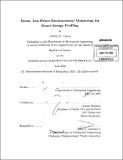Dense, low-power environmental monitoring for smart energy profiling
Author(s)
Turza, Ashley K
DownloadFull printable version (7.326Mb)
Other Contributors
Massachusetts Institute of Technology. Dept. of Mechanical Engineering.
Advisor
Joseph Paradiso.
Terms of use
Metadata
Show full item recordAbstract
Recent architectural trends have included exploring open space and the extensive use of glass as building material. While the details of these large, light-exposed, open-air environments can be modeled as thermal fluid systems in CFD simulations, the use of dense sensor networks can provide real-time monitoring of a building's airflow and thermal management systems without the need for computationally-intensive theoretical models, and can use this data to inform and advance these models. Sensor networks can provide an accurate picture of the actual conditions of a building and how those conditions can change over time, due to deterioration or external influences. The information gathered from such networks will be critical in determining the energy efficiency of a building. To do this, a sensor network made of two types of sensors, temperature-humidity and airflow, was deployed in the large, glass-enclosed atrium of the recently-completed MIT Media Lab Extension (E14) in late March 2010. Their performance was calibrated, monitored, and the preliminary results analyzed in conjunction with the external weather conditions in the Boston metropolitan area. The results show that while the use of the sensors in monitoring temperature and humidity is successful, the airflow sensors currently require a different solution to solve both the need for low-power consumption and resolution, range, and stability in its measurements.
Description
Thesis (S.B.)--Massachusetts Institute of Technology, Dept. of Mechanical Engineering, 2010. Cataloged from PDF version of thesis. Includes bibliographical references (p. 49).
Date issued
2010Department
Massachusetts Institute of Technology. Department of Mechanical EngineeringPublisher
Massachusetts Institute of Technology
Keywords
Mechanical Engineering.